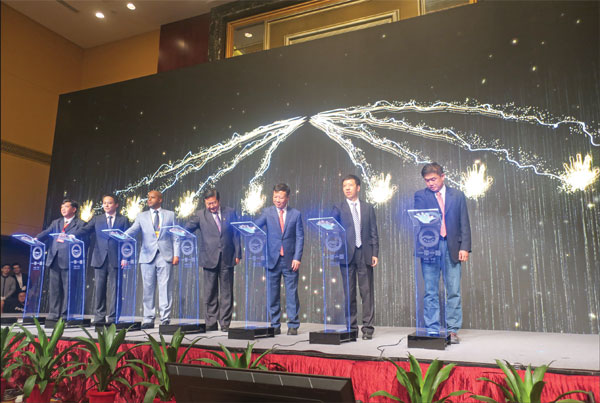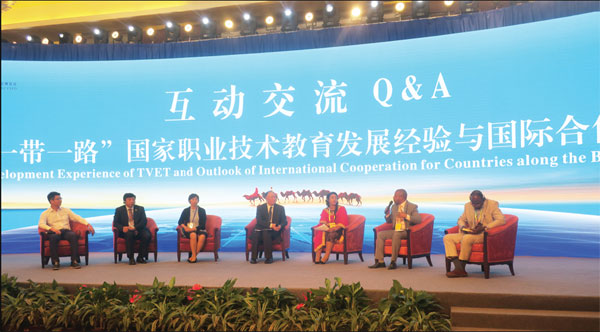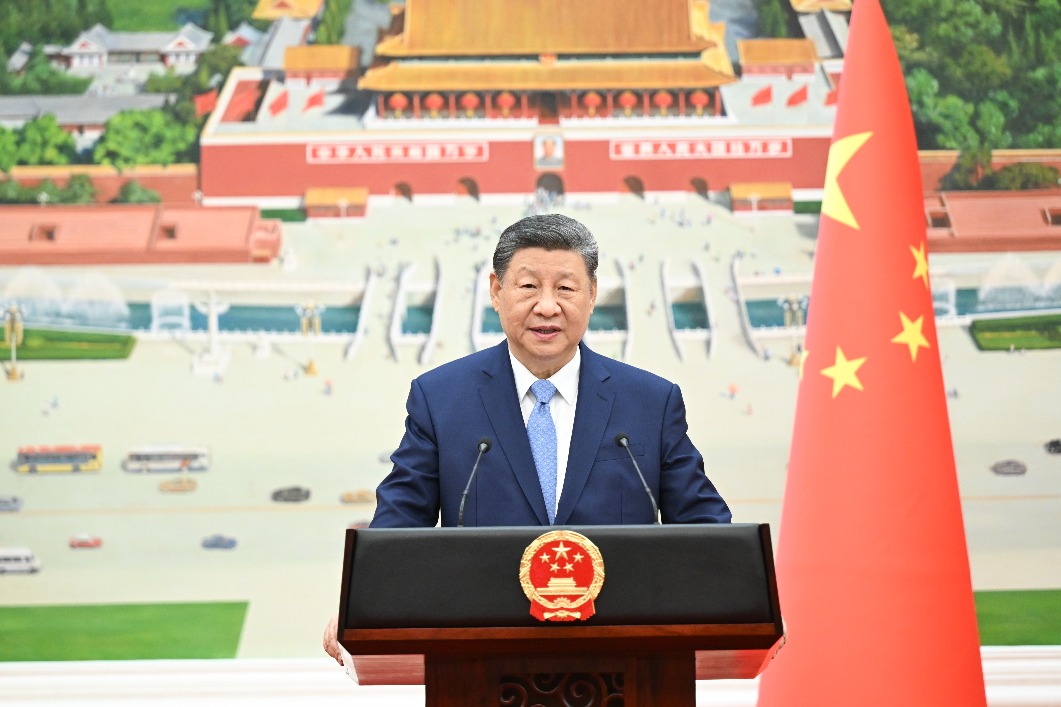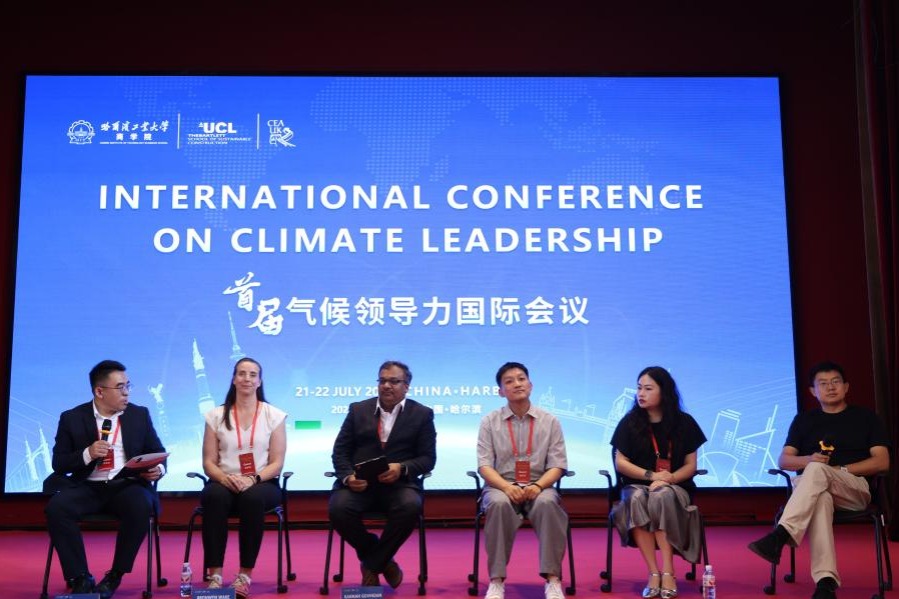China boosts vocational training

The importance of internationalizing vocational and technical training came into play on June 9 when countries participating in the Belt and Road Initiative met in China to launch the Belt and Road Alliance for Industry and Education Collaboration.
The event, held in Ningbo, Zhejiang province, also launched the Silk Road Business School. The gathering was sponsored by the China Education Association for International Exchange, the Ningbo municipal government and the Education Department of Zhejiang province, and was spearheaded by Ningbo Polytechnic College.
The college hopes to build a platform that will bring together Chinese technical vocational education and training institutes and their counterparts in Central and Eastern Europe and Africa to open doors for lecturers and student exchanges. It aims to quickly build a talent pool of graduates who are equipped with unique skills for a dynamic and competitive global market.
| The official launch of the Belt and Road Alliance for Industry and Education Collaboration and International Forum for Industry and Education Collaboration in China. Photos by Lucie Morangi / China Daily |
| Representatives from Chinese technical institutions and African governments hold a panel discussion at the launch of BRAIEC in China. |
The move comes against the backdrop of global alliances that are generating new demands, structures and systems requiring new skills and knowledge.
Sun Youzhong, a professor at Beijing Foreign Studies University, says that global initiatives such as the Belt and Road, cooperation between China and Central and Eastern European countries and the Forum on China-Africa Cooperation have increased demand for unique talent in the labor market.
"Over the recent past, we have witnessed more Chinese graduates going abroad rather than professionals coming from the United States and Europe, as has been the trend previously," he says.
"The trend is shifting from the East-West dialogue into multicivilization," Sun adds.
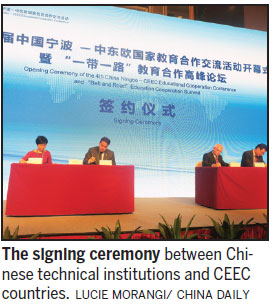
According to Sun, the global market demands graduates who are versatile, possess new skills and understand different cultures and languages. "Students need to be multilingual and understand history, politics, culture, economy and societal changes that are key to the business decision-making process and operations," he says.
"This means that training institutions have to develop programs that integrate foreign language and cultural education," he adds, noting that the new Silk Road Business School will promote communication and cooperation and enhance internationalization of teaching and research in business.
Integrating foreign students in classes will enhance the sharing of knowledge about local culture and norms, which can help reinvigorate trade relationships, he says.
"The knowledge will support and deliver results for international production. It will also ease the recruitment process as companies seek locals with the much-needed expertise to manage international projects," Sun says.
Previously, China pursued collaborations with institutions in the United States and Europe to upgrade its own institutions to world-class level. Following the rapid economic transformation of recent years, these institutions have continued to play a key role in providing technical capacity.
Over the years, the sector has developed benchmarking systems that are recognized and recommended by the World Bank. These are the experiences the Chinese institutions would like to share with their counterparts, says Yu Yongming, an official from Zhejiang province's Education Department.
China has undergone steady transformation in its education over the years from quantity to quality, Yu says, adding that about 9.6 million more students graduate each year compared with 20 years ago.

He says his province has "recorded a 95 percent employment rate in the past 10 years, as most students find jobs upon graduation. Seventy-five percent of them secure jobs near their graduating schools. This is due to successful collaboration between industries and education."
Development and implementation of ideal policies have also strongly contributed to reforms in the education sector by developing guidelines to sustain and promote education quality, adding impetus to the collaboration between learning institutions and industries, experts say. Besides funding research and simulation programs in colleges, the enterprises offer apprenticeship opportunities to students and lecturers.
"So, this presents the perfect opportunity for the institutions to assist companies that are scaling up their business abroad and help them steer in unfamiliar operating environments," says Yu.
For it has not always been smooth sailing for Chinese companies abroad. According to Gong Jiayan, the managing director of AVIC International's project engineering company, the company's expansion ambition over the years has faced a shortage in the quality and quantity of labor.
"This is because some countries, especially in sub-Saharan Africa, are emerging from political instability and underinvestment in the education sector," Gong says.
Some countries have hardly any infrastructure for technical vocational education and training, while others use outdated equipment. These markets are characterized by high unemployment rates, as graduates are poorly equipped to work, especially in semi-skilled, labor-intensive sectors as well as new and emerging sectors.
"Competing national priorities consequently have seen countries continue to under invest in the technical vocational education training subsector, forcing foreign companies, investing in the country, to bridge this gap," says Gong. "We have had to increase our expenditure to develop capacity-building programs in countries like Kenya, Uganda, Ghana, Gabon and Zambia. These projects have been meaningful in our operational strategy abroad."
The alliance therefore promises to meet industrial demands of countries and will play an integral role in transforming socioeconomic development, says Zhang Huibo, the principal of Ningbo Polytechnic, who notes that more than 20 countries have shown interest in establishing Chinese colleges in their countries. "This is a great catalyst for poverty reduction," adds Zhang, noting that promising young people who cannot afford an education are eligible for government-sponsored scholarships.
Technical vocational education and training institutes face a new set of challenges, especially in government policies and regulations, experts say. The Chinese institutions are well advanced in terms of knowledge capital, compared with their counterparts in Europe and Africa, they say.
Chinese institutions say they are ready to offer more scholarship programs to ensure that best practices are shared. This is in addition to establishing joint research projects to enhance collaboration, staff exchanges and conferences that will bring together entrepreneurs and academia. Establishing Chinese institutes in foreign countries is also possible, experts say.
The proposals resonated well with Aryal Prahlad, undersecretary in Nepal's Ministry of Education. He says the country's higher education lags behind China's, and such an alliance would be a boost to its industrial ambitions. "We have more than 400 programs currently running, but we still lack the technical capacity required to accelerate the country's economic development. This is what we are seeking in this alliance," he says.
He adds that the country's rich cultural heritage could be the starting point for exchanges with countries participating in the Belt and Road Initiative.

Moreover, Africa believes that the platform will increase the visibility of its technical vocational education and training subsector, says Ibrahim Garba, the vice-chancellor of Ahmadu Bello University in Zaria, Nigeria.
The country's vocational institutions have over the years been relegated to the informal sector, says Garba. "Only one percent of the labor market in my country graduate from these institutions. Most of the people learn on the job, which is not sustainable," he says.
He adds that low industrialization has also denied students opportunities for internships, depriving them of the practical skills needed for employment.
Ergogies Tesfaye, vice-president at Wachamo University and a representative from Ethiopia's Ministry of Education, says that although the country has adopted a German model for technical training, it has been unable to form linkages between academia and the industrial sector.
"We have more than 450 (technical vocational education and training) institutions, but the programs are not demand-or market-driven. With the internationalization of this subsector, we are looking for real partnership to help in bringing the necessary reforms to our higher-education system."
George Gaukrelidze, head of the labor market analysis division in Georgia's Ministry of Economy and Sustainable Development, says the country has to first change its cultural mentality and wrong attitude about technical and vocational institutions.
"We are also grappling with low competition, a factor that China has risen above by infusing competition into this subsector, leading to innovation and technological advancement that has driven its industrial revolution," he says.
lucymorangi@chinadaily.com.cn
(China Daily European Weekly 06/16/2017 page1)
















